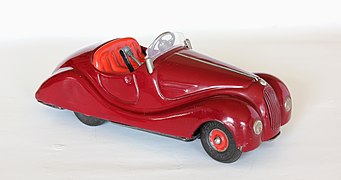Schuco
Schuco is a manufacturer of toys , especially model cars made of die-cast zinc and tin toys .
Company history
The Schuco company was founded in Nuremberg in 1912 by Heinrich Schreyer and the toolmaker Heinrich Müller , who had previously worked for the Bing toy factory . Schreyer left the company in 1918, and Adolf Kahn joined him as a partner. First, the company said Schreyer & Co , but then left in 1924 the name Schuco Enter consisting of the composition of Sch Reyer u . Co . originated.
Under the trademark Schuco produced were, among others, made of cloth character doll produced in the United States of George Borgfeldt & Company , as well as Louis Wolf & Co. were expelled.
In 1936 the company brought the first Schuco car onto the market and amazed the professional world with the technical precision and the remarkable features of the miniatures. In the same year the company had over 100 employees. The inventor and company owner Heinrich Müller further increased the mechanical finesse of the soon world-famous model cars. He developed mechanical gearboxes, steering wheel controls and hand brakes. In 1939, the partner Adolf Kahn had to emigrate to New York because of his Jewish descent , but remained with Schuco in business.
After the Second World War, production was resumed with the pre-war models and new toys were soon added. The models from before the war include the “Schuco Examico 4001”, an open two-seater with clockwork, four-speed H gearshift, clutch for engaging reverse gear (a small black button on the outside left), Ackermann steering and handbrake. The car was built until the 1950s, after the war with the imprint "Made in US-Zone Germany". The model has been available as a replica since the 1980s. From 1951 new developments came onto the market, including the Varianto system, in which the vehicles could be steered via a spiral wire cable or drove on a ring made of spiral wire, and which could be expanded to include switches and crossings. The tin toy cars were free interpretations of models. With the Mirako models , cars were constructed which, similar to Patent 1001 from 1936, were provided with an additional transverse drive and could not fall off the table.
After Heinrich Müller's death in 1958, his son Werner continued the business. In addition to the classic models, the range has also been expanded to include ships, large construction models (Ingenico cars to assemble), airplanes (Radiant models) and specialties such as an Alweg monorail based on the model of the monorail at Disneyland Resort .
In the sixties a broad paradigm shift took place within the toy industry and the tin toys that had dominated up to that time were replaced by plastic and injection-molded models. Many of the well-known Nuremberg manufacturers ( Distler , Günthermann ) had to give up and Schuco was sold to the British DCM (Dunbee-Combex-Marx) group in 1976 . When this company became insolvent in 1980, Gama-Mangold acquired the rights and relocated the company's headquarters to Fürth . Schuco was now producing replicas of its old tin toys for the collectors' market. The studio racing car and the classic car series were added to the program to build on earlier successes.
In 1993 the GAMA and Trix brands were merged by the parent company Mangold. The historical sheet metal models should be clearly separated from the 1:43 models. In the first half of the 1990s, Schuco therefore produced these models for some time at today's tin toy manufacturer KOVAP . The 1:43 range has been upgraded to include numerous models. In 1996 the Trix and Gama brands were sold to Märklin and Schuco became independent again. New developments and revitalization of the classic range, e.g. B. Schuco Piccolo, helped it to be successful, tin toys are now offered in the Schuco Classic Collection .
When the Mangold family withdrew completely from the toy business in 1999, Schuco was sold to the Simba-Dickie-Group in Fürth.
- Schuco Examico 4001 - Original from 1948
- Schuco Studio 1050 Mercedes Grand Prix 1936 - replica from 1982
literature
- Rudger Huber: Schuco - Complete catalog of all models. Battenberg, Augsburg 1995, ISBN 3-89441-208-9 .
- Rudger Huber: Schuco - legendary toys. Battenberg, Regenstauf 2007, ISBN 978-3-86646-014-0 .
- Chris Knox: Schuco. Engineering miracle. Nostalgic toys for collectors. Heel, Königswinter 2003, ISBN 3-89880-226-4 .
- Ulrich Schweizer: Schuco figures from the pre- and post-war period , Schweizer, Schallstadt-Mengen, ISBN 3-00-014982-1
- Ulrich Schweizer: Schuco - vehicles from the pre- and post-war period. Schweizer, Schallstadt-Mengen 2005, ISBN 3-00-017245-9 .
- Ulrich Schweizer: Schuco - Prototypes, Rarities & Vehicles from 1967 - 1976 , Schweizer, Schallstadt-Mengen 2007, ISBN 3-00-020287-0
- Ulrich Schweizer: Schuco - The vehicles of the Classic Collection , Tin-and-Toys Verlag, Schallstadt-Mengen 2013, ISBN 978-3-00-043812-7
- Andreas A. Berse: The Schuco saga - 100 years full of marvels. Delius Klasing Verlag, Bielefeld 2012, ISBN 978-3-7688-3555-8 .
- Fritz Ferschl, Peter Kapfhammer: The Schuco Book - The fascinating world of technical toys. Droemer Knaur, Munich 1984, ISBN 3-426-26151-0 .
- Stefan Schmidt: The great Schuco book - collector's catalog , ISBN 3-00-012644-9 .
- Hans-Heinrich Henning: Piccolo by Schuco - historical car models. seven marketing, Hamburg 2003, ISBN 3-00-012198-6 .
Web links
- Schuco website
- Schucoworld - An interactive Schuco collection
- Schucomania - Schuco collector's site with forum, gallery and news blog
- Schuco collect on the private website Sammeln-sammler.de
Individual evidence
- ^ Jean Bach: International Handbook of Doll Brands. A doll identification book , English original title: The main street dictionary of doll marks , translated by Wolfgang Hartmann, Munich: Laterna Magica, 1989, ISBN 3-87467-389-8 ; P. 116











